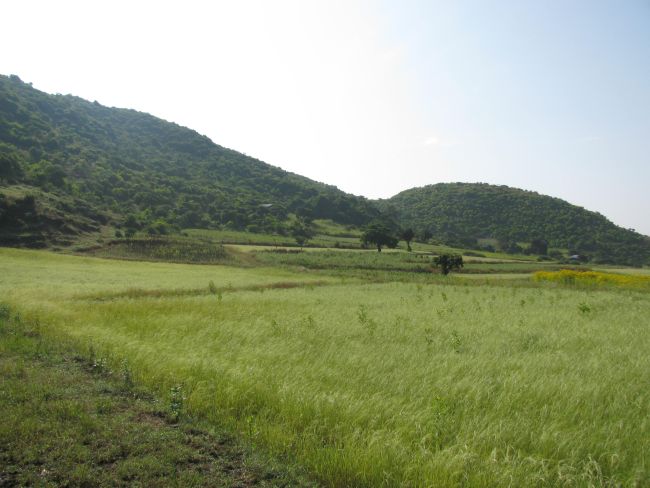Ethiopian communities attempt to save biodiversity and livelihoods
Denuded slopes and landscapes sliced open by gullies are common sights in the northern highlands of Ethiopia where deforestation, erosion and loss of biodiversity are on the rise. For a population largely dependent on smallholder agriculture, environmental degradation is a significant threat to food production and livelihoods. But a recent study shows that exclosures – sections of communal land protected from grazing and crop production – could help communities turn back the clock before it’s too late.

According to the study, exclosures can restore degraded ecosystems, diversify incomes and support the livelihoods of smallholder farmers. However, setting aside these communal areas can increase pressure on other shared resources, such as fuelwood and grazing land. To address these trade-offs and support a balance between short-term and long-term needs, community participation and incentives are vital throughout the project.
Exclosure benefits
Exclosures promote the regeneration of native plants and trees, which help retain moisture and nutrients in the soil and prevent erosion. Exclosures also reduce greenhouse gasses, thereby lessening the consequences of climate change; during ‘carbon sequestration’, plants pull CO2 from the atmosphere and store it in their stems and leaves. Trees are particularly important for long-term carbon storage.
Aside from these long-term environmental benefits, exclosures can also support farmers by providing fodder for livestock and habitat for beneficial insects and pollinators. The natural vegetation can even distract pests from consuming crops. For many smallholder farmers, fertilizers and other chemical inputs may be too costly. These environmental benefits are crucial for smallholder farmers to sustainably produce food.
Case study – Gomit watershed
Despite a long rainy season and moderately fertile soil, the communities in the Gomit watershed of the Amhara regional state face food deficits each year. Land degradation – largely due to the expansion of farmland, overgrazing, population growth, drought and the need for fuelwood – is one of the main contributors to these shortages. In 2006, the communities responded to the challenge by forming a committee to legally plan and manage exclosures, which have been growing in popularity throughout the region.
The communities, community watershed team, government agencies and NGO’s worked together to select sections of communal grazing land, which could be converted into exclosures. Instead of fences, paid guards ensure they are not disturbed beyond annual fodder harvests.
The community watershed team also plans and manages the construction of soil and water conservation structures within the exclosures (e.g., terraces, small basins) to prevent erosion and retain water.
Comparing communal grazing land with exclosures that were one to seven years old, the study found significant differences in biodiversity. The communal grazing lands only had four plant species whereas the exclosures hosted nine to 32 different plant species. Exclosures also had substantially more shrubs and trees.
In a household survey, 80% of respondents said that land degradation, largely due to deforestation, is a problem, and the majority believe exclosures help reverse this trend. They also said that some farmers have benefitted economically with increased honey production and fattened livestock due to better fodder.
However, the need for fuelwood is one of the biggest constraints to the success of exclosures. With 90% of households dependent on fuelwood for heating and cooking purposes, turning communal lands into exclosures increases pressure on the remaining land to meet this need.
Looking ahead
According to the study, the expansion and success of exclosures will require governments and NGO’s to increase awareness of sustainable land practices; they will also need to continuously work with communities to understand and measure the costs and benefits of exclosures. Increased participation of women could help to ensure the needs of both men and women are met and support more equitable management of natural resources. Out of the nine watershed team members, seven are men.
“The provision of incentives that can support local communities to adopt a long-term conservation approach is also important,” said Wolde Mekuria Bori, Researcher of Land Resources Management at the IWMI-Ethiopia office.
Incentives could include livestock fattening programs and better credit to expand beekeeping.
While the study does not provide solutions to the fuelwood issue, it does show that exclosures can simultaneously benefit the environment and livelihoods, and that communities are interested in working together to find creative, sustainable solutions.
[hr top=”yes”/]
To read:
Mekuria, W.; Langan, S.; Johnston, R.; Belay, B.; Amare, D.; Gashaw, T.; Desta, G.; Noble, A.; Wale, A. 2015. Restoring aboveground carbon and biodiversity: a case study from the Nile basin, Ethiopia. Forest Science and Technology. [doi: 10.1080/21580103.2014.966862]
This work has been undertaken as part of the CGIAR Research Program on Water, Land and Ecosystems (WLE).
Expanding and sustaining exclosure land management. Colombo, Sri Lanka: International Water Management Institute (IWMI). CGIAR Research Program on Water, Land and Ecosystems (WLE). 4p. https://cgspace.cgiar.org/handle/10568/42340

